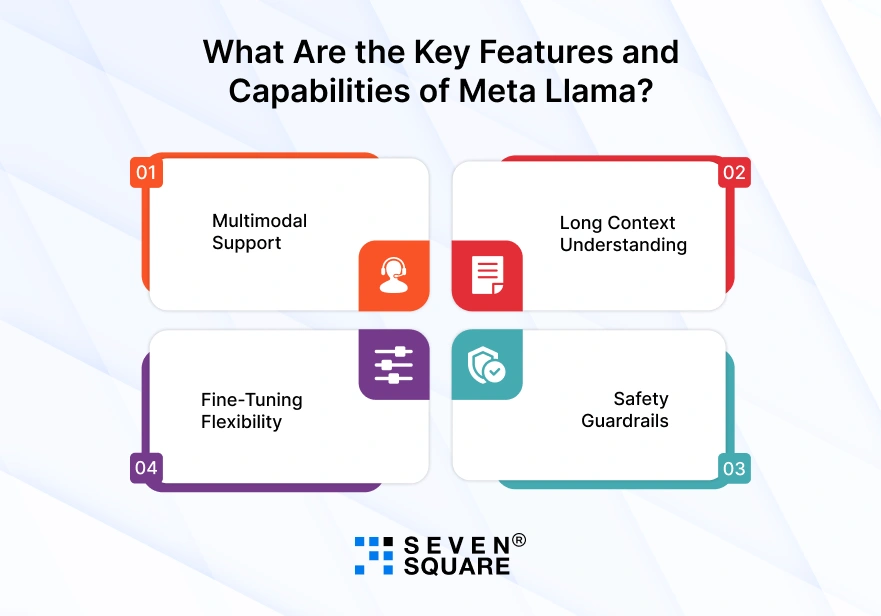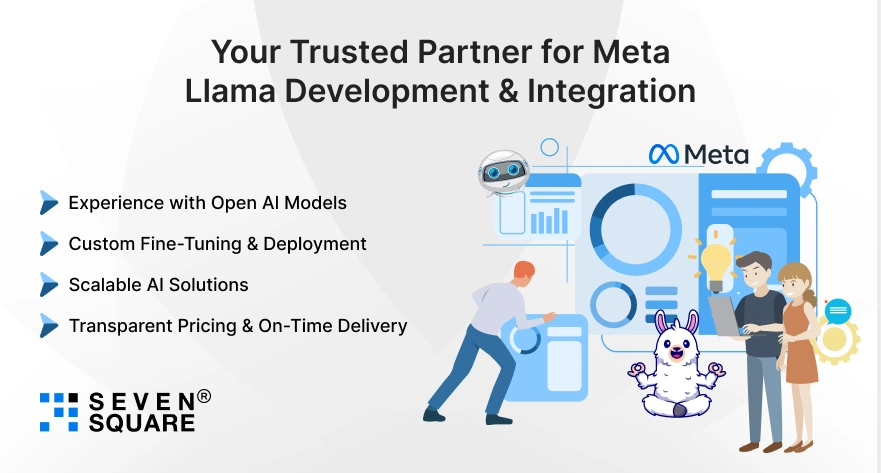Artificial intelligence is growing faster than ever, and something new happened in 2025.
If you’ve been following AI trends, you’ve probably heard that everyone is talking about Meta Llama, the newest open generative AI model.
Unlike closed systems like ChatGPT, Gemini, or Claude, Meta’s Llama takes a completely different path; it’s open, flexible, and developer-friendly.
That means businesses and developers can now build, fine-tune, and deploy powerful AI systems using Meta’s technology, without being locked into one provider.
Meta Llama gives companies the ability to create custom AI experiences, automate workflows, and train their own models, all while keeping control over data and costs.
So, whether you’re comparing Llama vs ChatGPT, or exploring how to integrate open AI models into your enterprise, this blog is for you.
Here you will learn about Meta Llama’s Open Generative AI Model and how to use Meta Llama in Enterprise Applications.
What Is Meta Llama? Learn About Meta’s Open Generative AI Model
Meta Llama is an open-source generative AI model developed by Meta AI, the same team behind Facebook, Instagram, and WhatsApp.
The goal behind Llama is to make advanced AI accessible to everyone, from small startups to large enterprises.
Unlike most proprietary AI models, Meta Llama open model allows developers to access its architecture, weights, and documentation, giving complete freedom to train and fine-tune it for specific use cases.
Here’s a quick breakdown of how it changed:
- Llama 2: Introduced open AI to the world with improved reasoning and multilingual capabilities.
- Llama 3: Better performance and coding support for developers.
- Llama 3.1: Added better context understanding and expanded model sizes.
- Llama 4: The latest version with multimodal features (text, image, and code), longer context windows, and improved accuracy.
These versions together form the foundation of what many now call the future of open generative AI.
How Llama Architecture Works?
- Trained on trillions of tokens from diverse datasets.
- Uses transformer-based architecture (like GPT models).
- Supports fine-tuning for domain-specific tasks.
- Offers API access and enterprise deployment flexibility.
We help clients to deploy Llama 4 features for automation, create chatbots, or integrate Llama into their existing business software.
Why Is Everyone Talking About Meta Llama?
There’s a reason why Meta Llama is dominating tech conversations this year: it’s open and business-ready.
Here’s why it stands out:
- Open Licensing Model: Llama’s license allows developers and companies to use, modify, & deploy it freely for commercial purposes.
- Business Applications: Enterprises are using Llama for customer service bots, predictive analytics, and content automation at scale.
- Fine-Tuning Capability: Companies can customize the model with their own data to create AI that truly understands their domain.
This combination of flexibility + transparency is what makes it so popular among developers and enterprises.
From Llama generative AI vs ChatGPT comparisons to real-world implementations, it’s clear that businesses are seeing Meta Llama for developers as a cost-effective alternative to closed AI models.
What Are the Key Features and Capabilities of Meta Llama?

Our team has explored the Llama 4 architecture & features, and it’s clear that Meta is changing open AI model capabilities with the new Meta Llama API access.
These features make it easier than ever to build AI-based apps that are smarter, safer, and more flexible.
1. Multimodal Support (Text, Image, Code)
- Meta Llama understands text, images, and code in one unified framework.
- This multimodal support lets businesses create intelligent assistants, visual search engines, or even AI code review tools that can interpret multiple data types at once.
2. Long Context Understanding
- Llama 4’s long context window allows it to process longer conversations, documents, or project files without losing track.
- This is a major change for businesses that rely on large datasets or need AI that “remembers” context throughout a session, from customer support threads to research summaries.
3. Fine-Tuning Flexibility
- One of the strongest aspects of Meta Llama’s architecture is its fine-tuning flexibility.
- Businesses can now train the model on domain-specific data, like legal text, healthcare reports, or code repositories, using Meta Llama fine-tuning services to align perfectly with their use case.
4. Safety Guardrails: Llama Guard & Prompt Guard
- Meta has built strong safety guardrails into Llama 4, including Llama Guard and Prompt Guard.
- These ensure responsible AI use, reduce harmful outputs, and protect both user and brand integrity.
Go Through the Comparison of Amazon Bedrock vs ChatGPT.
Meta Llama vs GPT-5 vs Claude 4.5
Here you can see a quick comparison between Meta Llama vs GPT-5 vs Claude 4.5 to determine which one is best for you.
| Feature | Meta Llama 4 | GPT-5 | Claude 4.5 |
|---|---|---|---|
| Architecture Type | Open-source transformer | Proprietary transformer | Proprietary transformer |
| Multimodal Support | Text, Image, Code | Text, Image | Text, Image |
| Fine-Tuning Access | Available | Limited | API-based |
| Context Length | 128K+ tokens | 200K tokens | 150K tokens |
| Safety Systems | Llama Guard, Prompt Guard | GPT Shield | Constitutional AI |
| API Access | Open via Meta Llama API | OpenAI API | Anthropic API |
Our Suggestion: Llama 4 stands out for its open architecture, API flexibility, and strong fine-tuning support, which makes it ideal for custom enterprise applications.
How Businesses Are Using Meta Llama? (With Real Use Cases)
Utilizing the power of Meta Llama deployment for business can be incredible.
Here are a few ways companies are transforming workflows using Meta Llama’s open AI model capabilities.
1. AI-Based Customer Support Bots
- Startups are using Meta Llama fine-tuning services to build customer support bots that actually understand user intent and tone.
- Imagine an AI that empathizes, resolves, and remembers context.
2. Domain-Specific Content Generation
- Enterprises in healthcare, finance, and education are deploying Meta Llama to generate high-quality, compliant, domain-specific content.
- With its fine-tuning flexibility, the model can adapt to brand voice and industry terms smoothly.
3. Predictive Analytics and Coding Assistants
- Software companies and data teams use Meta Llama 4’s multimodal support to build smart coding assistants and predictive analytics tools.
- The model can read code, interpret user prompts, and even suggest optimized algorithms to reduce development time.
With Meta Llama API access, businesses can easily integrate these capabilities into their existing tools to create custom AI solutions that truly perform.
How to Start Using Meta Llama in Your Business or App?
Thinking about bringing Meta Llama 4 into your business?
We make the process smooth, from Meta Llama model consulting to deployment and optimization. Here’s how you can start:
Step-by-Step Guide
1. Access the Model (via Cloud or API)
- Sign up for Meta Llama API access through Meta’s platform or a trusted integration partner like us.
2. Fine-Tune It for Your Data
- Use Meta Llama fine-tuning services to train the model on your specific business data, tone, and objectives.
3. Integrate Into Your Workflow or App
- Our experts handle full Meta Llama integration, whether it’s a web app, chatbot, analytics platform, or enterprise system.
4. Monitor & Optimize Results
- With ongoing Meta Llama model consulting, we help you evaluate performance, apply updates, and continuously improve AI outcomes.
Your Trusted Partner for Meta Llama Development & Integration

We are your long-term AI innovation partners. Our team has hands-on experience with open AI model integration, Meta Llama model consulting, & enterprise-level fine-tuning.
- Experience with Open AI Models: Llama, GPT, and Claude integration expertise.
- Custom Fine-Tuning & Deployment: Personalized according to your business data and goals.
- Scalable AI Solutions: Built using the latest Llama 4 architecture & features.
- Transparent Pricing & On-Time Delivery: No surprises, just results.
We provide a full-cycle Meta Llama integration service, from strategy to deployment. We help you turn AI into a real business advantage.
Ready to build your next AI product with Meta Llama? Contact Us Now!
Meta Llama vs ChatGPT: Which Model Should Your Business Choose?
When it comes to choosing between Meta Llama vs ChatGPT for enterprise, businesses often ask, which one delivers better performance, flexibility, and cost efficiency?
We’ve worked with both Llama 4 and GPT-5, so here’s a clear side-by-side comparison to help you decide.
Quick Comparison: Llama 4 vs GPT-5 Performance
| Feature | Meta Llama 4 | ChatGPT (GPT-5) |
|---|---|---|
| Openness | Open-source (customizable) | Closed-source (limited access) |
| Pricing | Free base model; paid fine-tuning | Subscription or API pricing |
| Scalability | High – deploy anywhere | High – cloud-based only |
| Use Cases | Fine-tuned enterprise AI, on-premise tools | Conversational AI, general-purpose apps |
| Integration | Available via Meta Llama API | Available via OpenAI API |
Advantages & Disadvantages of Meta Llama 4
| Meta Llama 4 Advantages | Meta Llama 4 Disadvantages |
|---|---|
| Fully open-source architecture, perfect for companies that need control. | Requires technical setup and AI expertise. |
| Lower Meta Llama licensing cost and flexible deployment options. | May lack certain GPT-exclusive plugins or ecosystem support. |
| Ideal for AI model consulting in India and global enterprises. | |
| Better fine-tuning and data privacy since it can run on-premise. |
Advantages & Disadvantages of GPT-5
| GPT-5 Advantages | GPT-5 Disadvantages |
|---|---|
| Ready-to-use and backed by OpenAI’s infrastructure. | Closed-source nature limits deep customization. |
| Offers great language fluency and plug-and-play convenience. | It can become expensive at scale due to token-based pricing. |
What We Suggest?
- If you value control, scalability, and cost savings, choose Meta Llama 4.
- If your business prefers ready-made AI tools, GPT-5 is simpler to start with. Our team can help you compare, deploy, and optimize for enterprise performance.
What is the Future of Open Generative AI with Meta Llama?
The future of Meta Llama looks promising.
As open AI models innovate in 2025, businesses can expect even more powerful versions like Llama 5, real-time multimodality, and smarter multi-agent systems that collaborate smoothly.
We believe open AI ecosystems will dominate the next wave of innovation because openness fuels adaptability, transparency, and creativity.
While closed models like GPT and Claude will keep advancing, Meta Llama’s open approach ensures that innovation remains accessible to all, from startups to global enterprises.
The future of open AI model innovation 2025 belongs to those who adapt to flexibility, and Meta Llama leads the charge.
FAQs
- Meta Llama is an open AI model used for natural language processing, content creation, coding assistance, and predictive analytics.
- Meta Llama is open-source and customizable, while ChatGPT and Gemini are closed models.
- It’s ideal for enterprises needing control over data and fine-tuning.
- Yes, Meta Llama supports fine-tuning for domain-specific content. We offer Meta Llama fine-tuning services for this purpose.
- Industries like healthcare, finance, eCommerce, and logistics use Meta Llama for automation, insights, and content generation.